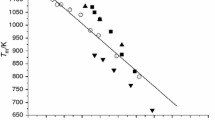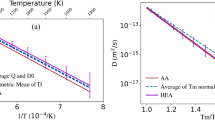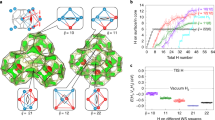Abstract
Surface diffusion plays a crucial role in the formation of the shape and morphology of growing nanoparticles and nanofilms. Bulk heterodiffusion occurs at uneven (irregular) concentrations of several metals, in the presence of free energy in the system. Atoms of each sort tend to be evenly distributed in volume and form mixed bonds. In this paper, we propose an approach for modeling diffusion processes in nanoalloys by the vacancy mechanism. It is a hybrid Monte Carlo approach based on computing the probability for a transition of each atom belonging to the first three coordination spheres. The energy of the system is computed with a tight binding potential. The efficiency of the approach is demonstrated simulating Au–Ag bimetallic nanofilms with a different number of vacancies in the crystal lattice and a different temperature.
Access this chapter
Tax calculation will be finalised at checkout
Purchases are for personal use only
Similar content being viewed by others
References
Abraham, A., Nie, H., Schoenitz, M., et al.: Bimetal Al-Ni nano-powders for energetic formulations. Combust. Flame 173, 179–186 (2016). https://doi.org/10.1016/j.combustflame.2016.08.015
Ali, S., Myasnichenko, V.S., Neyts, E.C.: Size-dependent strain and surface energies of gold nanoclusters. Phys. Chem. Chem. Phys. 18(2), 792–800 (2016). https://doi.org/10.1039/C5CP06153A
Babicheva, R.I., Semenov, A.S., Dmitriev, S.V., Zhou, K.: Effect of grain boundary segregations on martensitic transformation temperatures in NiTi bi-crystals. Lett. Mater. 9(2), 162–167 (2019). https://doi.org/10.22226/2410-3535-2019-2-162-167
Bashkova, D.A., Gafner, Y.Y., Gafner, S.L.: On the prospects of using a phase transition in Ag nanoclusters for information recording processes. Lett. Mater. 9(4), 382–385 (2019). https://doi.org/10.22226/2410-3535-2019-4-382-385
Cleri, F., Rosato, V.: Tight-binding potentials for transition metals and alloys. Phys. Rev. B 48(1), 22–33 (1993). https://doi.org/10.1103/PhysRevB.48.22
Davoodi, J., Mehri, L.: Molecular dynamics simulation of solidification of ag-x%aunanoalloy. Defect Diffus. Forum 312–315, 143–148 (2011). https://doi.org/10.4028/www.scientific.net/DDF.312-315.143
Galashev, A.Y., Rakhmanova, O.R., Kovrov, V.A., Zaikov, Y.P.: Molecular dynamics study of the stability of aluminium coatings on iron. Lett. Mater. 9(4), 436–441 (2019). https://doi.org/10.22226/2410-3535-2019-4-436-441
Hodak, J.H., Henglein, A., Giersig, M., Hartland, G.V.: Laser-induced inter-diffusion in AuAg core-shell nanoparticles. J. Phys. Chem. B 104(49), 11708–11718 (2000). https://doi.org/10.1021/jp002438r
Husic, B.E., Schebarchov, D., Wales, D.J.: Impurity effects on solid—solid transitionsin atomic clusters. NANO 8(43), 18326–18340 (2016). https://doi.org/10.1039/C6NR06299G
Harrison, W.A.: Tight-binding methods. Surf. Sci. 299–300, 298–310 (1994). https://doi.org/10.1016/0039-6028(94)90662-9
Jahangiri, M., Bajgholi, A., Fallah, A., Khodabandeh, A.: Effect of annealing methodand applied stress on aging behavior of copper-aluminum bimetals. J. Ofalloys Compd. 816,(2019). https://doi.org/10.1016/j.jallcom.2019.152676
Julin, J., Napari, I., Vehkamäki, H.: Comparative study on methodology in molecular dynamics simulation of nucleation. J. Chem. Phys. 126(22), 224517-1–224517-8 (2007). https://doi.org/10.1063/1.2740269
Korznikova, E.A., Sharapov, E.A., Khalikov, A.R., Dmitriev, S.V.: Simulation of the binary alloy ordering kinetics during diffusion bonding. Mater. Technol. Des. 1(1), 58–64 (2019) (in Russian)
Li, J.H., Dai, X.D., Liang, S.H., et al.: (2008) Interatomic potentials of the binary transition metal systems and some applications in materials physics. Phys. Rep. 455(1–3), 1–134 (2008). https://doi.org/10.1016/j.physrep.2007.09.004
Li, X.-Y., Zhu, B., Qi, R., Gao, Y.: Real-time simulation of nonequilibriumnano-crystal transformations. Adv. Theory Simul. 2(1), 1800127-1–1800127-8 (2018). https://doi.org/10.1002/adts.201800127
Lobzenko, I.P., Khalikov, A.R., Sharapov, E.A., et al.: Monte-Carlo simulation of the process of diffusion welding of two metals through a gasket. Basic Probl. Mater. Sci. 16(1), 47–54 (2019). https://doi.org/10.25712/ASTU.1811-1416.2019.01.007
Makarov, S.V., Olimov, M.G., Plotnikov, V.A., Hlebutina, S.V., Yakovleva, O.S.: Formation of a diffusion zone at the interface of nickel/aluminum bimetal. News of Altai State University 99(1), 29–33 (2018). https://doi.org/10.14258/izvasu(2018)1-04
Mao, S., Zhang, Y., Li, H., et al.: Writing of nanowiresvia high viscosity-induced nano diffusive layer. J. Mater. Chem. C 5(45), 11666–11671 (2017). https://doi.org/10.1039/C7TC03962J
Myasnichenko, V.S., Starostenkov, M.D.: Formation of fivefold axes in the FCC-metal nanoclusters. Appl. Surf. Sci. 260, 51–53 (2012). j.apsusc.2012.03.039
Myasnichenko, V., Kirilov, L., Mikhov, R., Fidanova, S., Sdobnyakov, N.: Simulatedannealing method for metal nanoparticle structures optimization. Adv. Comput. Ind. Math.: Stud. Comput. Intell. 793, 277–288 (2019). https://doi.org/10.1007/978-3-319-97277-0_23
Myasnichenko, V., Sdobnyakov, N., Kirilov, L., Mikhov, R., Fidanova, S.: Structural instability of gold and bimetallic nanowires using Monte Carlo simulation. In: Recent Advances in Computational Optimization. Studies in Computational Intelligence, vol. 838, pp. 133–145 (2020).https://doi.org/10.1007/978-3-030-22723-4_9
Ren, H.S., Ren, X.Y., Xiong, H.P., et al.: Nano-diffusionbonding of Ti2AlNb to Ni-based superalloy. Mater. Charact. 155, 109813 (2019). https://doi.org/10.1016/j.matchar.2019.109813
Samsonov, V.M., Sdobnyakov, N.Y., Bembel, A.G., Sokolov, D.N., Novozhilov, N.V.: Thermodynamic approach to the size dependence of the melting temperatures of films. Bull. Russ. Acad. Sci.: Phys. 78(8), 733–736 (2014). https://doi.org/10.3103/S1062873814080310
Shirzadi, A., Wallach, E.: New method to diffusion bond superalloys. Sci. Technol. Weld. Joining 9(1), 37–40 (2004). https://doi.org/10.1179/136217104225017125
Wu, X., Sun, Y.: Stable structures and potential energy surface of the metallicclusters: Ni, Cu, Ag, Au, Pd, and Pt. J. Nanopart. Res. 19, 201 (2017). https://doi.org/10.1007/s11051-017-3907-6
Yuldasheva, A.R., Nugaeva, N.M.: Magnetoelectric interaction at the interface in thesuperlattices of multiferroic: Monte Carlo study of the phase transitions. Lett. Mater. 9(3), 354–359 (2019). https://doi.org/10.22226/2410-3535-2019-3-354-359
Zakharov, P.B., Markidonov, A.V., Starostenkov, M.D., et al.: Effect of shock post-cascade waves on the interface boundary of bimetals Ni-Al, Ni-Fe. Basic Probl. Mater. Sci. 13(1), 77–83 (2016) (in Russian)
Zaporozhets, T.V., Gusak, A. M., Podolyan, O. M.: Evolution of pores in nanoshells- a competition of direct and inverse Kirkendall effects, Frenkel and Gibbs–Thomson effects: the phenomenological description and computer simulation. Prog. Phys. Metals 13(1), 1–70 (2012) (in Russian). https://doi.org/10.15407/ufm.13.01.001
Zhang, Z., Chen, C., Liu, G., et al.: Enhancement of bonding strength in Ag sinter joining on Au surface finished substrate by increasing Au grain-size. Appl. Surf. Sci. 485, 468–475 (2019). https://doi.org/10.1016/j.apsusc.2019.04.228
Zolnikov, K.P., Kryzhevich, D.S., Korchuganov, A.V.: Atomic mechanisms of highspeedmigration of symmetric tilt grain boundaries in nanocrystalline Ni. Lett. Mater. 9(2), 197–201 (2019). https://doi.org/10.22226/2410-3535-2019-2-197-201
Zorya, I.V., Poletaev, G.M., Rakitin, R.Y., Ilyina, M.A., Starostenkov, M.D.: Interactionof impurity atoms of light elements with self-interstitials in fcc metals. Lett. Mater. 9(2), 207–211 (2019). https://doi.org/10.22226/2410-3535-2019-2-207-211
Acknowledgements
This work was partially funded by Russian Federation of Basic Research, project number 20-37-70007, by the Ministry of Science and Higher Education of the Russian Federation in the framework of the State Program in the Field of the Research Activity, project number 0817-2020-0007. Stefka Fidanova was supported by the Bulgarian NSF under the grant DFNI-DN 12/5 and by the Grant No BG05M2OP001-1.001-0003, financed by the Science and Education for Smart Growth Operational Program and co-financed by the European Union through the European structural and Investment funds. LeoneedKirilov and Rossen Mikhov were supported by the National Scientific Program “Information and Communication Technologies for a Single Digital Market in Science, Education and Security (ICTinSES)”, Ministry of Education and Science—Bulgaria, and by the Grant No BG05M2OP001-1.001-0003, financed by the Science and Education for Smart Growth Operational Program and co-financed by the European Union through the European structural and Investment funds.
Author information
Authors and Affiliations
Editor information
Editors and Affiliations
Rights and permissions
Copyright information
© 2022 The Author(s), under exclusive license to Springer Nature Switzerland AG
About this chapter
Cite this chapter
Myasnichenko, V., Mikhov, R., Kirilov, L., Sdobnykov, N., Sokolov, D., Fidanova, S. (2022). Simulation of Diffusion Processes in Bimetallic Nanofilms. In: Fidanova, S. (eds) Recent Advances in Computational Optimization. WCO 2020. Studies in Computational Intelligence, vol 986. Springer, Cham. https://doi.org/10.1007/978-3-030-82397-9_11
Download citation
DOI: https://doi.org/10.1007/978-3-030-82397-9_11
Published:
Publisher Name: Springer, Cham
Print ISBN: 978-3-030-82396-2
Online ISBN: 978-3-030-82397-9
eBook Packages: Intelligent Technologies and RoboticsIntelligent Technologies and Robotics (R0)




